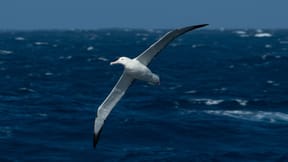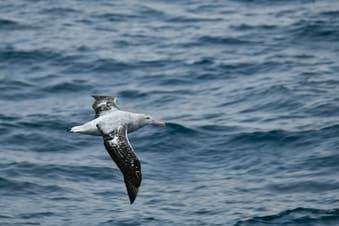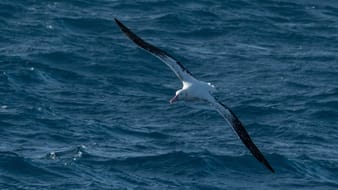The Wandering Albatross
There is no mightier bird than the Wandering Albatross, a bird surrounded by lore and impressive in their size and wingspan. These birds are one of the largest seabirds on Earth and one of the most remarkable creatures we might see on our voyages to Antarctica and the Sub-Antarctic islands.

Wandering Albatross
OF MYTH AND LEGEND
- In the past it was thought that seeing albatross flying around a ship in the middle of the ocean was an omen of storms, wind, and bad weather to come
- Sailors felt it was very unlucky to kill albatross because they thought that the souls of deceased sailors inhabited them
- The phrase ‘an albatross around my neck’ alludes to Samuel Taylor Coleridge’s poem “The Rime of the Ancient Mariner,” in which a sailor who shoots a friendly albatross is forced to wear its carcass around his neck as punishment.
- Albatross come from the genus Diomedea, which refers to Diomedes, a hero in Greek mythology
NO WANDERING EYE HERE
- They do not mature sexually until around 11 years of age
- Males and females will bond with the use of ritualized dances, and their bonds last the lifetime of the pair
- Albatrosses mate for life and can live to be over 60 years old
- They breed every 2 years, with an egg laid between the middle of December and early January. The parents take turns incubating the egg for around 11 weeks
- These birds are colonial, in that they nest together for the most part on remote oceanic islands
SIZE MATTERS
- The wingspan of a Wandering Albatross can be up to three and a half meters
- Due to their size (and the fact that they spend much of their time in the air) they have virtually no natural predators
- Albatross are able to soar through the sky without flapping their wings for several hours at a time, actually using up less energy in the air than they would while sitting in their nest.
- As the birds age, the dark patches on their wings recede so the bird becomes whiter over time.
TRAVEL FAR & WIDE
- Albatrosses are the most efficient travelers of all vertebrates on the planet.
- These amazing birds can travel over over 22,000kms on a single foraging flight, and circumnavigate the globe in just 46 days – all while expending almost no energy.
- Albatross can fly almost three times as fast as the windspeed, using a ‘dynamic soaring’ technique that allows them to manoeuvre using their massive wings
- They can fly up to 40 km per hour
- Albatross have a mechanism within the base of the wing to “lock” it in an extended position. This means the bird doesn’t need to strain to keep its wings out.
If you are fascinated by birds then you have to come on a trip and see a Wandering Albatross for yourself! Bird lovers and even non-birders find spotting Albatross an amazing experience. Reach out to our team to learn more about our voyages any time


